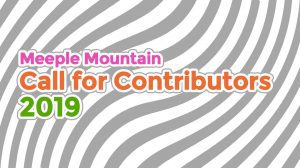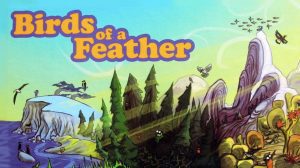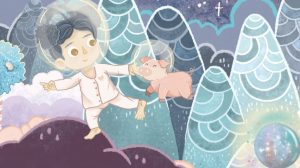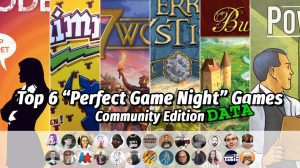What have you been up to since we last talked to you?
PM: It’s been a while, hasn’t it? Aside from trudging through this miserable pandemic, I’ve been working on getting more game designs off the ground. I was still very new to board game design when Tiny Towns released. As a result, I didn’t have a working library of projects. Since then, I’ve found a great local design group and have started and finished a few designs.
 Has the success of Tiny Towns affected your life, your designs?
Has the success of Tiny Towns affected your life, your designs?
PM: Absolutely. It’s still weird to see strangers playing my little game online and at conventions. I was a freelance writer when Tiny Towns released, but this year I shifted to full-time game design, at least for a while. As for my designs, I try to keep goals clear and simple so players always know where they are headed. In Tiny Towns, it’s “get the resources you need to make a building, then work on the next one.” Most of my games aren’t quite that simple, but I try to keep goals as straightforward as I can so that players always have a sense of progress and accomplishment.
You worked with Josh Wood on the expansions for Tiny Towns. What was it like to welcome another designer into your creation?
PM: Josh Wood and I worked very closely on the tinkering and balancing of Tiny Towns, since he was the developer. As soon as we started talking about expansions, I asked him if he wanted to co-design them with me. It would have been too weird to go off on my own and come up with a system, then share it with him. We worked on Tiny Towns: Fortune, Villagers, and Tiny Trees together from the start. It felt completely natural to partner up on the expansions. He’s a fantastic co-designer, and I knew from our very first meeting that he understood the core of Tiny Towns.
We’ve had some behind-the-scenes conversations recently at MM about the various roles involved in bringing a game to light. Can you elaborate on the difference between a designer and developer for our readers?
PM: I’m sure the role varies from company to company, but in working with Josh Wood and Neil Kimball on Tiny Towns and Wormholes, the developer is essentially the project lead. They adjust the balance and mechanisms of a game and may also be in charge of things like art direction and production details. I think of developers as being akin to editors for books. The designer is the person who created the initial design. I’ve definitely heard people use “developer” to mean “designer,” which might come from the video game industry, where “developer” is the accepted name for game creators.
 What can you tell us about your upcoming game, Wormholes, from AEG? What sort of game is it?
What can you tell us about your upcoming game, Wormholes, from AEG? What sort of game is it?
PM: Wormholes is a peaceful spacefaring game about warping around a galaxy via wormholes. It’s a route-building game that has players flying to distant planets to set up their wormhole network and deliver passengers. It’s a few steps up in complexity from Tiny Towns, but the experience is much less tense. You’re regularly using other players’ wormholes and earning points when they use yours. While everyone is competing, there’s a sense of togetherness as you link up a galaxy of planets.
Was this game inspired by the novel The Long Way to a Small, Angry Planet? If so, what can you tell us about that inspiration?
PM: Yes, absolutely. It’s one of my all-time favorite books, written by the talented Becky Chambers, and it wasn’t until my 2nd read that I thought “this wormhole network thing sounds like a game design.” The inspiration ends there, but I was really drawn to this idea of making a wormhole from planet A to B and B to C, then hopping through those wormholes to link up C to A.
How excited would you be if Becky Chambers played Wormholes, and enjoyed it? She’s apparently a board gamer you know.
PM: I’d love a chance to just tell her how her book inspired me, and playing Wormholes with her would be a dream.
Are there any other books you’re really loving right now?
PM: Piranesi by Susanna Clarke was my favorite read of 2021. The premise is hard to describe briefly, but it’s a good book to go into unaware anyway. It’s a fantasy novella with an endearing protagonist in a mysterious realm of statues and corridors, and it packs a lot of love and magic into a very short read. It’s rare that I read a book that transports me like this one did. Her first novel, Jonathan Strange & Mr Norrell had a board game adaptation—maybe this one could too!
With regard to the design process, does beginning with a very specific thematic inspiration—such as a work of fiction—alter the way you think about a game’s mechanics?
PM: Yes, especially because I’m often a “mechanics first” designer. With something like Wormholes, I knew that I wanted the game to be about flying through space and warping through wormholes, and that the mechanics had to replicate that feeling. Having this core so clearly defined meant I couldn’t stray from it during the design process. Whenever a mechanic was giving me trouble, I could ask “does this contribute or take away from the experience of warping through space via wormholes?”
 You’re going to be working with the Flatout Games team on a new game called Fit to Print. Give us the lowdown, what is Fit to Print about?
You’re going to be working with the Flatout Games team on a new game called Fit to Print. Give us the lowdown, what is Fit to Print about?
PM: Fit to Print puts each player in charge of a newspaper in the small town of Thistleville. It has a few different modes, but the main way to play is real-time. In just a few minutes, you have to flip tiles from the center of the table to find a good mix of articles, ads, and photos. Then, once you think you have the right amount, you switch to laying out the front page of your paper. Once you’ve started laying things out, you are stuck with whatever tiles you’ve taken. It’s very frantic and silly, and at the end of each round, you (hopefully) end up with a nice-looking front page.
Did you design this game with the Flatout team in mind? Did they approach you or vice versa?
PM: I did not—I was actually inspired by my wife’s job as a reporter and editor for a local paper. Working with Flatout came about through a sort of chance meeting. At GenCon 2019, I was at an AEG event prepping for Big Game Night along with the Flatout Crew (who were about to release the brilliant Point Salad). I got chatting with them and happened to have a prototype on hand. We played a game of Fit to Print together, and I honestly didn’t even think of it as a pitch. I had a great time hanging out with them through the rest of the convention, and toward the end of the show they said they’d like to consider publishing it.
Is this your first crowdfunded game? How has that prospect informed the design process (thinking of stretch goals, add-ons, etc.)?
PM: Yes, this is a first for me. I didn’t design it with crowdfunding in mind, but while working with Flatout we’ve come up with a handful of meaningful ways to add content. We’re still working out the details on stretch goals, but we have a lot of fun ideas.
This is fascinating. From the surface, it seems like publishers have to have some sort of Pandora’s box (of fun) ready to unleash on the world during crowdfunding campaigns. Can you talk a bit more about this process and how it impacts you as a designer?
PM: To be honest, I’ve only backed a couple of Kickstarter campaigns, so I’m learning a lot about stretch goals and the like as I go. Flatout Games tries to focus on component quality if funding milestones are met, rather than more content. Although there are a few things we’re testing now that we may be able to include as stretch goals. The idea of coming up with stuff right as funding goals are reached sounds terrifying—I want to make sure that anything we add to the game holds up and doesn’t feel half-baked. At the same time, the base game has to be a complete design without the additional content.
So far all of your designs push the player count beyond four—a distinction which I love since I (Bob) have a large family. Do you specifically aim for higher counts? Are there elements of play that change as a result of designing for more players?
PM: My gaming group is either two people (my wife and me) or five or more people. So in addition to aiming for high player counts, I also try to make sure my designs work well at two. On the higher end of the scale, it can be tough to keep downtime to a minimum and to keep all players engaged when it’s not their turn. Fortunately, in Fit to Print, there are no turns. The two-player version presented some unique scoring challenges, as there’s a mechanism that punishes the player with the lowest ad revenue after three rounds. But other than a small tweak on how ad revenue works, the two player game has no rules changes.
Any other games you’re working on that you’d care to share?
PM: I don’t have anything that’s very far along, but I have a handful of designs that I’m hoping will be pitch-ready by the end of 2022. One is Antiquarian, a tile-laying game about buying and selling antiques from your antique shop. The others are still in the early prototype stages, but I’m very hopeful for them.



 Has the success of Tiny Towns affected your life, your designs?
Has the success of Tiny Towns affected your life, your designs? What can you tell us about your upcoming game, Wormholes, from AEG? What sort of game is it?
What can you tell us about your upcoming game, Wormholes, from AEG? What sort of game is it? You’re going to be working with the Flatout Games team on a new game called Fit to Print. Give us the lowdown, what is Fit to Print about?
You’re going to be working with the Flatout Games team on a new game called Fit to Print. Give us the lowdown, what is Fit to Print about?







Add Comment